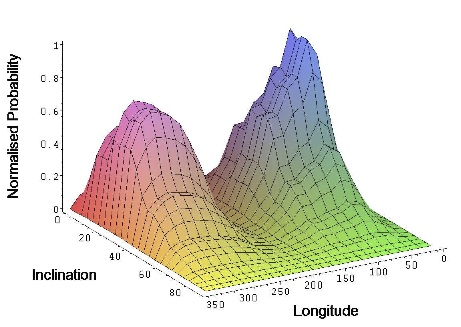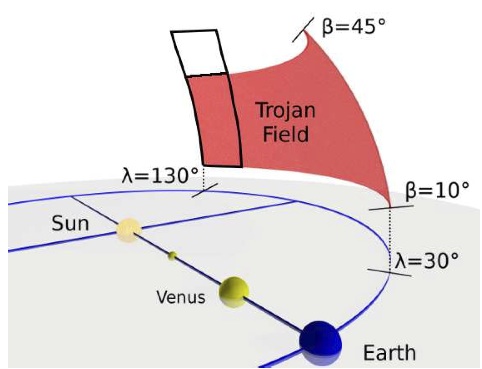Today is apparently Solar System day on Astrobites (check out Kirit’s nice post this morning about the challenges of observing lightning on Mars!).
Trojan Asteroids in the Solar System
One of the many cool observations that have come from the WISE telescope survey this year has been the discovery of the first Trojan asteroid orbiting at the same semi-major axis as the Earth (see this astrobite for another cool WISE discovery—a brand new class of brown dwarfs!). Trojan asteroids orbit near the L4 and L5 Lagrange points of planets orbiting the Sun. The first was discovered in 1906 in Jupiter’s orbit; since then, thousands have been found in the orbit of Jupiter. The inner terrestrial planets also have these Trojan asteroids, which orbit roughly 60 degrees ahead of and trailing behind each planet; four Martian Trojans have been discovered so far. Finding these objects in the terrestrial planet orbits and characterizing their composition can tell us whether the Trojans formed at the same time and place as the planets or whether they were captured gravitationally afterwards. This information provides contraints on early Solar System formation and evolution.
Earth Trojans: Challenges of Observation
Trojan asteroids in Earth’s orbit are surprisingly challenging to find. Because of the geometry — with the asteroids orbiting 60 degrees from the Earth — you can only observe them close to dawn and dusk at fairly low altitudes in the sky (much like the ‘evening star’ Venus). Many of the surveys for near-Earth Asteroids to date have focused on finding the asteroids that are most likely to collide with the Earth (which seems prudent). These potential impactors lie close to the ecliptic. Because dynamicists predict that the Trojan asteroids will be most stable between 10 and 45 degrees of inclination above or below the ecliptic (as shown in figure 1), the searches for potential impactors will miss the majority of the Trojans.

This figure shows the normalized probability contour for Earth Trojan bodies. The peaks show the values of longitude and inclination at which we are most likely to find asteroids.
Solar system surveys find objects by looking for apparent motions that differ from the motions of the background stars (e.g. KBO surveys). These types of surveys would not necessarily flag Trojan asteroids as potential asteroids in their search algorithms because the geometry of the observations means that they would move in a different way — largely along the line of sight with small apparent motion — than ‘normal’ near-Earth asteroids.
Optimizing Earth Trojan Surveys
The authors of this paper outline a way to optimize future surveys for these Earth Trojans. They combine two dynamics models of stable Trojan orbits — one constraining orbital inclination from the ecliptic, the other constraining heliocentric longitude (see the first figure for a better idea of the geometry) — and determine that 63% of potential objects should be within their suggested search area, from an inclination of 10 to 45 degrees above and below the ecliptic and a longitude of 30 to 130 degree (L4) and 240 to 340 degrees (L5).

This figure shows the geometry of the observations of Earth Trojans at L4. The Earth is shown in blue, orbiting around the Sun. The red area shows the limits of the field containing ~63% of Trojans according to models, from 10 degrees to 45 degrees of inclination and 30 degrees to 130 degrees of longitude. The black rectangle (filled with red) shows the smaller area they propose to observe, resulting in the entire field (red area) being imaged over the course of a year.
They determine that because the size of the region is so large (>1000 square degrees) a widefield survey telescope such as LSST will be necessary. By observing twice within a few days (to catch the apparent motion of the asteroid) every two months, the whole region would be surveyed within a year (since Trojan asteroids are at the same semi-major axis as Earth, they will pass through the sidereal field once per year). They determine that the observing time can be minimized by observing a smaller region of sky and using the Earth’s revolution around the Sun to survey the entire field. Minimizing this time is very important because they are limited by the amount of time that the field is up after dusk or before dawn; also, using large telescopes such as LSST will be very competitive for telescope time. Their approach would take just a few minutes per session (before or after the primary science mission of the night), two days a week, for a year.
Studies like this, which combine the works of theorists (running predictive models) and observers (planning their observational surveys) are very important for understanding how to best use the telescope time available for the most interesting scientific output.




